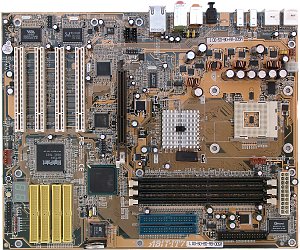Abit IT7 (i845E) Mainboard
|

The MAX series was already touched upon in the Abit AT7 Board review. This
line doesn't have legacy ports such as COM, LPT, PS/2 which are becoming
things of the past because of new high-speed buses. Instead, the board
is overcrowded with such buses. The board won't please everyone: for example,
when upgrading a system you will need a lot of money for replacing peripherals
with old interfaces for connection to a PC (the boards of the MAX series
are rather expensive). But if you assemble a computer from the very beginning
this is a good choice.
We received the board without a package, documentation or any accessories,
but the production samples will have packaging identical to the AT7
model.

The layout is not that bad considering a lot of various functional elements,
that is why if it were not a small number of PCI slots which usually take
a lot of space... Still, there are some downsides: the IDE RAID connectors,
audio-ins and an AGP slot have not very handy positions (when a video card
is installed it's difficult to handle memory modules). It can be difficult
as well to reach a jumper when the board is already installed. Its function
is shown on the textolite.
The 3-channel switching voltage regulator incorporates 6 capacitors
of 3300 uF and 3 of 1200 uF.
The following controllers are integrated:
-
audio controller based on the ALC650 AC'97 codec supporting 5.1 audio systems
and having a connector for front audio inputs/outputs;
-
network controller based on the Realtek RTL8100B chip supporting 10BaseT/100BaseTX;
-
IDE RAID controller based on the HighPoint HPT374 chip supporting RAID
0, 1 and 0+1 on the ATA133 protocol;
-
USB 2.0 bus controller based on the VIA VT6202 chip supporting 4 ports;
-
IEEE1394 bus controller based on the Texas Instruments TSB43AB23 supporting
3 ports.
The board has reset and power buttons, and a POST controller based on 2
7-segment LEDs.
Non-unsoldered connectors: SPDIF-In connector (TosLink).
The system monitoring is supported by the Winbond W83627HF-AW chip.
What is controlled:
-
voltage of processor, AGP bus, memory, +1.25, +3.3, +5 and +12 V, VBAT
and +5 V Standby;
-
speed of 3 fans;
-
temperatures of the processor (a built-in sensor), and the board (a built-in
sensor).
There are 2 connectors for adjustable and 3 for unadjustable connection
of fans.
Brief characteristics of the board: memory slots - 3 DDR SDRAM;
expansion slots - AGP/ 4 PCI; I/O ports - 3 IEEE1394/ 10 USB 2.0; dimensions
- 305x245 mm.

Adjustment can be carried out with:
| jumpers and switches |
Jumper to clear up the CMOS |
|
| BIOS based on the AWARDBIOS 6.00PG from Phoenix |
Setup of memory timings |
+ |
CAS Latency, Active To Precharge Delay, RAS to CAS Delay, RAS
Precharge |
| Setup of memory frequency |
+ |
at FSB 100 MHz:
CPU/Memory = Auto, 1:1, 3:4
at FSB 133 MHz:
CPU/Memory = Auto, 1:1, 4:3 |
| Setup of AGP bus |
+ |
|
| Setup of PCI bus |
- |
|
| Changeable scaler of AGP and PCI buses |
+ |
PCI (AGP/2) = 33 MHz, 37 MHz, 44 MHz, FSB/3, FSB/4 |
| Manual assignment of interrupts |
+ |
|
| Changeable FSB frequency |
+ |
100-250 MHz in 1MHz steps |
| Changeable CPU multiplier |
+ |
x8-x24 |
| Changeable core voltage |
+ |
1.1-1.85 V in 0.025V steps |
| Changeable memory voltage |
+ |
2.5, 2.6, 2.7, 2.8, 3.0, 3.1, 3.2 V |
| Changeable chipset voltage |
- |
|
| Changeable AGP bus voltage |
- |
|
We used the latest available version of the BIOS - BIOS 8H.
At the rated frequencies the speed is not striking, however the overclocking
potential is excellent, and as far as functions are concerned, this is
one of the best solutions on the market and it can be a nice base for a
powerful computer meant, for example, for video editing, for a file server
or for a powerful workstation.
Test results:
Write a comment below. No registration needed!
|
|
 |
|
|
|

